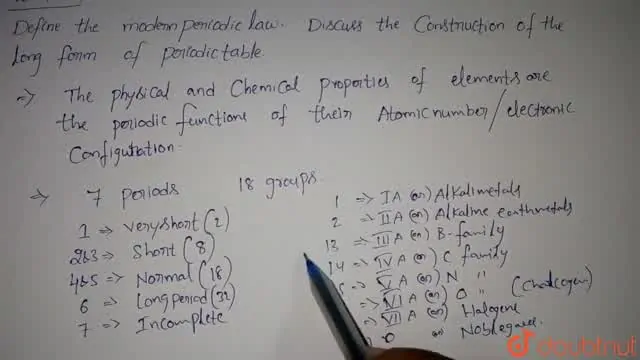Define the mordern periodic law . Discuss the construction of the long form of the periodic table . Solution in Telugu
The important characteristic property of an element is found to be its 'atomic number' and not atomic weight. Accordingly, the periodic law was modified- "The physical and chemical properties of the elements are perioidic functions of their atomic number". Later on it was found that while deciding the properties of an element, its electronic configuration plays a found that while deciding th properties of an element, its electronic configuration plays a very important role. So Bohr constructed the long form of the periodic table, based on the electronic configurations of the elements. The periodic law can be stated as "The physical and chemical properties of the elements are periodic functions of their electronic configuration".
Salient features:
(1) This table is prepared based on a fundamental property "atomic number".
(2) This table can be easily studied, remembered are reproduced.
(3) Similarities, difference are trends in properties are more clearly reflected in this table.
(4) Vertical columns are known as groups and horizontal rows are called periods.
(5) There are seven periods in this table. The first period consists of two elements only. Second and third periods contain 8 elements each. Fourth and fifth periods contain 18 eleements each. Sixth period consists of 32 elements. Seventh period is an incomplete period and consists of 19 elements.
(6) There are eighteen groups in this table. They are designated IA, IIB, IIIC, IVB, VB, VIB, VIIB, VIII, IB,IIB, IIIA, IVA, VA, VIA, VIIA, 0(American Convention of naming).
(7) The element in IA , IIA, IIIA, IVA, VA, VIA, and VIIA are known as representative elements or normals elements.
(8) The elements in IB, IIB, IIIB, IVB, VB, VIB, VIIB and VIII are called Transition elements.
(9) Zero group elements are placed at the extreame right of the table. These are called inert gases or noble gases. They possess stable ns2np2 configuration.
(10) Short periods are broken and long periods are extended to accommodate transition elements.
(11) Lanthanides and actinides are placed separately at the bottom of the periodic table.
(12) Based on the entrance of differentiating electron, the table is divided into four blocks. They are s-block, p-block, d-block and f-block. In the elements of s-block, differentiating electron enters into s-orbital. Similarly in the elements of p-block, d-block and f-block, the differentiating electron enters into p,d and f-orbitals respectively.
(13) Based on complete and incomplete electron shells and chemical properties, the elements are classified into four types. They are 1) Type I (Inert gas elements) 2) Type II (Representative elements) 3) Type III (Transition elements 4) Type IV (Inner transition elements).
(14) All the elements in a group possess similar properties, because they possess the same valence electron configuration.
Related Playlists
- BOOK - VGS PUBLICATION-BRILLIANTCHAPTER - CLASSIFICATION OF ELEMENTS AND PERIODICITY IN PROPERTIES EXERCISE - Short Answer Questions41videos
CLASSIFICATION OF ELEMENTS AND PERIODICITY IN PROPERTIES
- BOOK - VGS PUBLICATION-BRILLIANTCHAPTER - CHEMICAL EQUILIBRIUM AND ACIDS-BASESEXERCISE - ADDITIONAL QUESTIONS & ANSWERS8videos
CHEMICAL EQUILIBRIUM AND ACIDS-BASES
- BOOK - VGS PUBLICATION-BRILLIANTCHAPTER - ENVIRONMENTAL CHEMISTRYEXERCISE - LONG ANSWER QUESTIONS6videos
ENVIRONMENTAL CHEMISTRY
Similar Questions
On the basis of quantum numbers, justify that the 6th period of the periodic table should have 32 elements.
03:10View SolutionPCl5,PCl3 and Cl2 are at equilibrium at 500K and having concentration 1.59MPCl3,1.59MCL2 and 1.41MPCl5. Calculate Kc for the reaction PCl5⇔PCl3+Cl2
02:21View SolutionWhat is environmental pollution? How many types of pollution are encountered?
03:07View SolutionDefine the mordern periodic law . Discuss the construction of the long form of the periodic table .
08:42View SolutionState modern periodic law. How many groups and periods are present in the long form of the periodic table?
01:35View SolutionThe longest form of periodic table was constructed by……..
View SolutionWhat is modern periodic law ? Discuss the main features of the long form of the periodic table. Give its important advantages and disadvantages.
03:57View SolutionThe number of periods in the long form of the periodic table is:
03:10View SolutionWhat are groups and periods in the mordern periodic table ?
01:32View Solutionనవీన ఆవర్తన నియమాన్ని నిర్వచించండి . విస్తృత ఆవర్తన పట్టిక ఏ విధంగా నిర్మించబడిందో వివరించండి.
02:02View SolutionDefine Modern periodic law? Why many groups and periods are present in the long form of the periodic table?
01:59View SolutionNumber of short periods in the long form of periodic table
07:19View SolutionDefine modern periodic law. How is the long form of the periodic table constructed on the basis of this law?
06:07View Solutionआवर्त सारणी के दीर्घ स्वरूप में आवर्त संख्या बराबर होती है-
02:21View SolutionWhat is periodic law ? What advantages the long form of periodic table has got over Mendeleev's periodic table ?
03:10View Solution


